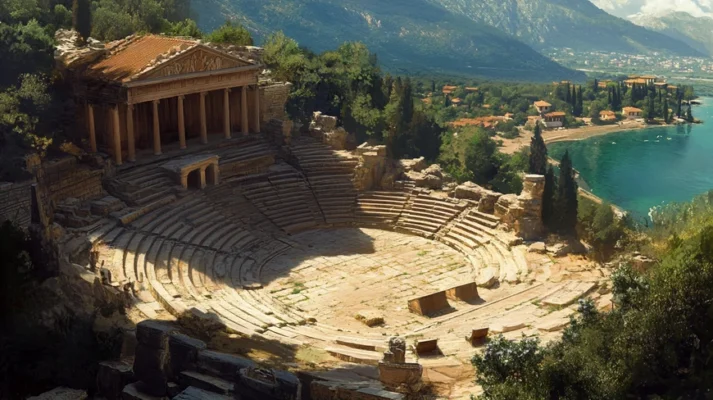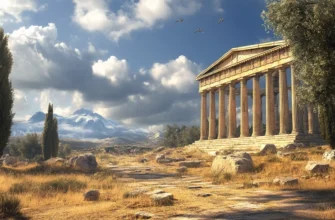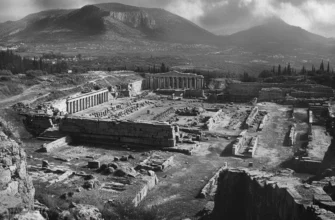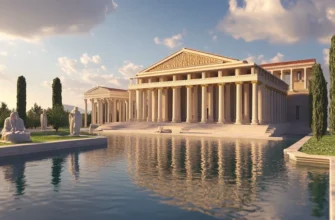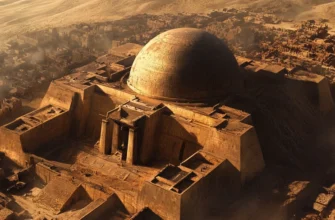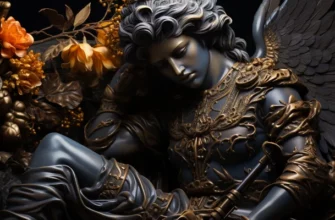Sikyon is one of the oldest city-states of Ancient Greece, located on the northern coast of the Peloponnese, not far from Corinth. Its history dates back to the pre-Archaic period, and the city reached its peak during the Archaic and Classical periods.
Sicyon was famous for its contribution to the development of Greek art, particularly painting, sculpture, and theater. According to legend, it was here that the technique of drawing shadow contours, the predecessor of painting, was invented. The city was home to such famous masters as the sculptor Lysippus, court artist of Alexander the Great.
Politically, Sikyon had a long history of tyranny and democracy. At various times, the city was ruled by tyrants, the most famous of whom was Cleisthenes, who carried out important reforms and promoted the development of art.
Sicyon was also an active participant in inter-city alliances and had significant economic influence thanks to crafts, agriculture, and trade. Archaeological excavations in the city have uncovered numerous temples, theaters, and workshops, confirming its cultural and economic importance.
Today, Sikyon is an important part of Greece’s historical heritage, providing an insight into the grandeur of ancient civilization.
- Geographical location
- History of Sicyon
- Foundation of the city
- Political structure and rulers
- Periods of prosperity and decline
- Culture and art
- Role in the development of Greek art
- Outstanding personalities
- Economy and trade
- Main archaeological sites of Sikyon
- Material culture finds
- Sikyon in museums
- Cultural heritage
- Conclusions
Geographical location
Ancient Sikyon was located on the northern coast of the Peloponnese peninsula in Greece, between two important cities, Corinth and Achaea. The city occupied a strategic position near the Gulf of Corinth, which provided convenient access to sea trade routes.
Originally, Sikyon was located on a coastal plain, but after the threat of attacks, the settlement was moved to a hill about 3 km from the coast. This gave the city natural protection and a panoramic view of the surrounding area.
Thanks to its fertile land and proximity to the sea, Sicyon had favorable conditions for agriculture, crafts, and trade. This location contributed to its economic development and cultural growth, as well as strengthening its political influence in the region.
Ancient Sikyon was located in the northern part of the Peloponnese, in an area formerly known as Sikyonia. On the modern map of Greece, its ruins are located near the town of Vasilikon on the outskirts of Corinth.
The city was located only 18 km west of Corinth and about 3 km from the coast of the Gulf of Corinth, which made it an important point for trade and communication between mainland Greece and other regions of the Mediterranean.
Thanks to this location, Sicyon was able to control part of the land and sea routes connecting northern Greece with the Peloponnesian city-states and had access to key resources and markets.
History of Sicyon
The history of Sicyon spans several eras and is distinguished by its cultural and political significance within Ancient Greece. The settlement dates back to the pre-Archaic period (around the 2nd millennium BC), when the city was known as Meken. The name “Sicyon” was established later and, according to legend, comes from the name of a mythical king.
In the Archaic period, Sicyon became one of the leading centers of art and culture. It was here that the foundations of Greek painting and sculpture were developed. At that time, the city was ruled by tyrants, the most famous of whom was Orestes Kleisthenes, who carried out administrative and cultural reforms, in particular supporting artists and theatrical competitions.
During the classical period, Sikyon retained relative autonomy, although it fell under the influence of stronger city-states such as Sparta and Corinth. The city participated in the Peloponnesian League and other inter-state alliances.
In the Hellenistic period, after the conquests of Alexander the Great, Sikyon became part of larger political unions, including the Achaean League. During this period, it experienced a cultural revival. The city was home to the outstanding sculptor Lysippus, who became Alexander’s court artist.
After joining the Roman Empire in the 1st century BC, Sikyon’s importance gradually declined. However, even in Roman times, the city retained a certain cultural role.
Today, Sikyon is an archaeological site that has preserved traces of the magnificent history of one of the most influential city-states of ancient Greece.
Foundation of the city
Sikyon is considered one of the oldest cities in Ancient Greece, and its history dates back to prehistoric times. Archaeological finds indicate the existence of a settlement in this area as early as the 3rd–2nd millennium BC, long before the emergence of the classical Greek city-states.
At first, the city was called Mekon, but later it was renamed Sikyon, which, according to legend, comes from the name of the mythical king Sikyon, grandson of the gods.
According to ancient sources, the founding of Sikyon is associated with the Ionian and Dorian tribes, who ruled the region in turn. After the Dorian invasion, the city became part of the Dorian League, while retaining its significant cultural identity.
Its geographical location near fertile lands and on the way to the Gulf of Corinth contributed to the rapid development of the settlement. Thanks to this, Sikyon quickly became a powerful economic and cultural center with close ties to neighboring cities and island colonies.
From the very beginning, Sikyon had a favorable strategic position, which allowed it to influence events in the region and avoid complete subjugation by stronger states.
Political structure and rulers
The political history of Sikyon is marked by changes in forms of government — from monarchy and tyranny to oligarchy and participation in alliances of Greek city-states. At various stages of its development, the city experienced both strong centralized rule and periods of democratic reform.
In ancient times, Sikyon, like most Greek cities, was ruled by kings. Greek mythology mentions a whole dynasty of legendary rulers, including King Sikyon, after whom the city was named. His successors were considered semi-mythical heroes who, according to legend, were related to the gods.
In the 7th–6th centuries BC, tyranny was established in the city, which became an important milestone in the history of Sikyon. The most famous ruler of this period was Cleisthenes of Sikyon. He came to power around 600 BC and distinguished himself as a reformer and patron of the arts.
Cleisthenes:
limited the political influence of the Dorians;
reorganized the tribal system, replacing the traditional Dorian tribes with new ones;
actively supported theater and the arts, including musical and dramatic competitions.
His reign became the “golden age” of Sikyon in cultural terms.
After the fall of the tyranny, Sikyon became an oligarchic republic, where power was in the hands of a wealthy aristocracy. The city retained relative autonomy, although it was often forced to adapt to the influence of stronger neighbors, including Sparta, Corinth, and Macedonia.
In the Hellenistic period, Sikyon joined the Achaean League, a federation of Peloponnesian cities that sought to counter Macedonian and Roman influence. During this period, the city was represented in the league’s joint governing bodies.
Periods of prosperity and decline
The history of Sikyon is divided into several key stages, reflecting both periods of rise and gradual decline of the city. Its development is closely linked to political events in the region, cultural achievements, and interaction with other Greek states.
Archaic period (8th–6th centuries BC) — the first heyday
This was one of the most vibrant periods in the history of Sikyon. The city flourished under the rule of tyrants, especially Cleisthenes, who carried out political reforms and made Sikyon the cultural center of Hellas. It was during this period that the first schools of painting and sculpture appeared, and music and theater developed. The Sikionians were renowned as masters of art and teachers for other city-states.
Classical period (5th–4th centuries BC) — stability and influence
During the Classical period, Sikyon retained its cultural and political importance, although it was no longer as dominant. The city existed mainly in the shadow of more powerful states such as Sparta and Athens, but remained a center of artistic production, particularly bronze sculpture. It was during this period that Lysippus, the court sculptor of Alexander the Great, worked in Sikyon.
Hellenistic period (4th–2nd centuries BC) — second heyday
After the conquests of Alexander the Great, Sikyon received a new impetus for development. The city joined the Achaean League and regained its political significance. At this time, the construction of public buildings continued, and architecture and philosophy developed. However, the city no longer had the autonomy it had enjoyed previously.
Roman period and decline (1st century BC – 1st century AD)
During the Roman rule, Sikyon finally lost its political independence. Although some cultural traditions were preserved, the city gradually turned into a provincial center. Most of the inhabitants migrated, and a significant part of the architectural structures fell into disrepair.
The decline of Sikyon continued for centuries, and it was only thanks to archaeological excavations in modern times that the greatness of its cultural heritage was revealed to posterity.
Culture and art
Sikyon is rightly considered one of the most important cultural centers of Ancient Greece. Its contribution to the development of fine arts, theater, music, and architecture was extremely influential, and many artists from Sikyon became famous far beyond the borders of their native city.
Painting and sculpture
Sicyon is considered the birthplace of the Greek school of painting. According to legend, it was here that one of the first forms of painting emerged — the depiction of a human shadow on a wall. The city was home to many outstanding artists, including
Polygnotos — one of the first painters to add depth and space to images.
Lysippus was a famous sculptor and court artist of Alexander the Great, who worked with bronze. His style was distinguished by its dynamism and naturalism.
Euphranos was a painter and sculptor who combined precision with idealization of forms.
The art school in Sikyon became a model for other Greek cities, and its masters taught in various parts of Hellas.
Theatre and music
Sikyon had its own theatre and actively developed musical and dramatic competitions, especially during the reign of the tyrant Cleisthenes. The city even had a reputation as a “theater school” where actors and musicians were trained.
The theater staged dramas, satirical plays, and musical compositions.
Musical agones (competitions) were held, which became popular throughout Hellas.
Architecture
The architecture of Sikyon combined the Doric style with local features. The city had
Temples dedicated to Apollo, Artemis, and Demeter.
Public buildings, including an agora and theaters.
Gymnasiums and palestrae, which served as centers of physical and cultural education.
Many of these structures have been partially preserved and have become objects of archaeological research.
The culture of Sikyon became the basis for the development of art in other parts of Greece. The city left a deep mark on the creative heritage of Hellas, influencing the aesthetics, technique, and organization of artistic life.
Role in the development of Greek art
Sicyon played one of the most important roles in the formation and development of ancient Greek art. Its art school was considered the most authoritative in Hellas, and the masters who worked or studied in Sicyon determined the direction of painting, sculpture, and architecture for many centuries to come.
- Center of art education
Sikyon became the first known center of systematic art education. There was an art school where students were taught proportions, perspective, drawing techniques, and the basics of composition. This approach to art education was revolutionary at the time and significantly raised the level of Greek visual arts.
- Development of sculpture
The city gave the world such artists as:
Lysippus — the chief sculptor of Alexander the Great, who changed the classical canons of proportion and introduced a new dynamic manner of depicting figures. His works were distinguished by their realism and psychological depth.
The Sikyonian school of sculpture emphasized harmony, body movement, and emotional expressiveness, which differed significantly from previous static canons.
- Painting and innovative techniques
The first attempts to create the illusion of volume and depth appeared in Sikyon.
Famous Sikionian artists used chiaroscuro, precise lines, and color schemes to achieve naturalism.
Sikion also became the place where the myth of the origin of painting arose — the legend of a girl who outlined the shadow of her beloved on the wall. This symbolizes the emergence of the linear contour — the basis of classical drawing.
- Influence on other cities
The students of the Sikyonian masters worked in Athens, Rhodes, Alexandria, and other cultural centers. Their influence can be seen in the development of Hellenistic art, which combined technical skill and emotional depth.
Thus, Sicyon became not just one of the centers of art — it was a school for all of Hellas, laying the foundations of the European artistic tradition.
Outstanding personalities
Ancient Sicyon gave the world a number of talented figures who left a deep mark on the art, politics, and cultural life of Hellas. Thanks to them, the city became famous far beyond the Peloponnese.
Cleisthenes of Sicyon (7th–6th centuries BC)
– Tyrant and reformer
– Famous for his struggle against the Dorian aristocracy, he carried out political and cultural reforms.
– Introduced a new system of tribal division and supported theatrical and musical competitions.
– His reign was a period of the first great rise of Sicyon.
Lysippus (4th century BC)
– World-class sculptor
– Court sculptor of Alexander the Great.
– Created over 1,500 sculptures (according to Pliny the Elder), including statues of Zeus, Heracles, and Alexander.
– Introduced new canons of body proportions that influenced the development of Hellenistic art.
Euphronios (4th century BC)
– Painter and sculptor
– Combined realism and high idealism in his work.
– Author of many famous frescoes and statues, including gods and historical figures.
– Worked in Athens but came from Sicyon.
Polygnotus (possibly associated with the Sicyonian school)
– One of the first Greek artists to use spatial composition and color to convey emotion.
– Although his exact origins are disputed, his style was strongly influenced by the Sikyonian school.
Telefan – renowned teacher and art theorist
– One of the mentors at the Sikyonian art school.
– His works on painting and composition were used as textbooks in the Hellenistic period.
These personalities shaped not only the face of Sikyon, but also the artistic tradition of all of Ancient Greece.
Economy and trade
The economy of Sikyon in ancient times was developed and diversified. Thanks to its favorable geographical location—near the Gulf of Corinth and fertile lands—the city became an important commercial and craft center of the Peloponnese.
Crafts and manufacturing
Sicyon was famous for its artistic products, which were not only a cultural but also an economic resource:
Sculpture and bronze casting — the production of statues and decorative items that were exported to other cities.
Ceramics — the city produced high-quality tableware with ornaments, often with artistic painting.
Painting workshops — the creation of iconography used to decorate public buildings and temples.
Agriculture
Surrounded by fertile plains, the city had a well-developed agricultural economy:
Olive, grape, and grain cultivation
Wine production — Sikyon wine was exported to other parts of Greece
Oil production — production of olive oil for domestic consumption and sale.
Trade
Sicyon had a port and maintained active maritime trade links with cities in Hellas, Asia Minor, Crete, and Italy. The main export goods were
artistic products (sculptures, paintings, ceramics)
wine and olive oil
bronze products
Main imports:
raw materials (metals, wood)
luxury goods (fabrics, perfumes, jewelry)
Monetary system
Sikyon minted its own coins as early as the Archaic period. The coins were decorated with images of gods and symbols of the city, which also indicates a high level of economic organization.
Thanks to the combination of crafts, agriculture, and trade, Sikyon was able to develop not only as a cultural center but also as a self-sufficient economic center that competed with cities such as Corinth and Argos.
Archaeological finds and heritage
Archaeological excavations in the territory of ancient Sikyon have uncovered a significant layer of material culture, confirming the city’s unique role in the political, artistic, and spiritual life of Ancient Greece. Thanks to these discoveries, we have an idea of the city’s structure, its architectural heritage, household items, and religious practices.
Main archaeological sites of Sikyon
- Ancient theater of Sikyon
Located on the southern slope of a hill, with a magnificent view of the plain and the sea.
Built in the 4th century BC, it could seat up to 10,000 spectators.
It had impressive acoustics and a classic Greek structure: an orchestra, a skene, and spectator benches.
It was used not only for theatrical performances but also for public gatherings.
- Agora (central square)
It was the economic and political center of the city.
Remains of columns, fountains, and foundations of administrative buildings have been found.
Craft workshops, shops, and warehouses were located nearby.
- Temples
The most famous is the Temple of Artemis Limnatida.
Shrines to Aphrodite, Apollo, and Demeter have also been found.
Unique fragments of temple sculptures, capitals, and bas-reliefs have survived to this day.
- Palestra and gymnasium
Buildings for physical and military training of young men.
Remains of columned halls, pools, and training grounds have been discovered.
Material culture finds
Pottery: painted vases, cups, jugs with Sikyonian ornaments.
Coins: with images of the coats of arms of Sikyon — often depicting a chimera or a griffin.
Artists’ and sculptors’ tools: brushes, styluses, casting molds.
Inscriptions: epigraphic monuments with the names of rulers, decrees, and dedications to the gods.
Sikyon in museums
Most of the artifacts are kept in:
The Archaeological Museum of Sikyon — located on the site of an ancient school of arts.
The National Archaeological Museum of Athens — sculptures and coins are on display.
European museums — some of the exhibits are in the Louvre, the British Museum, and the Vatican collections.
Cultural heritage
Sikyon is included in the register of cultural heritage sites in Greece.
The archaeological zone of the city is a site of national importance, protected by the state.
Archaeological expeditions, restoration work, and cultural festivals are regularly held here.
The archaeological heritage of Sikyon is not only the remains of antiquity, but also the key to understanding the development of Greek culture, art, and urbanism. It testifies to the high level of organization, aesthetics, and spiritual life of the Sikyon people.
Conclusions
Sikyon occupies a special place in the history of Hellas as a city that combined political stability, economic prosperity, and true cultural greatness. Its contribution to the development of ancient art, particularly sculpture, painting, and theater, laid the foundation for the further flourishing of Greek aesthetics in the Classical and Hellenistic periods.
As a political center, Sicyon demonstrated its capacity for reform and self-government, particularly under the leadership of figures such as Cleisthenes. As an economic center, it was a model of the successful combination of agriculture, crafts, and maritime trade. As a cultural center, Sicyon produced masters who set the standards of beauty, harmony, and technical perfection for many centuries to come.
The city’s archaeological heritage — numerous temples, a theater, an agora, works of art, and tools — attests to the high standard of living, organization, and creative potential of the Sicyonians.
So, Sikyon is not just another ancient Greek city. It is a source of artistic inspiration, cultural heritage, and historical significance that has left a deep mark on the treasure trove of world civilization.
